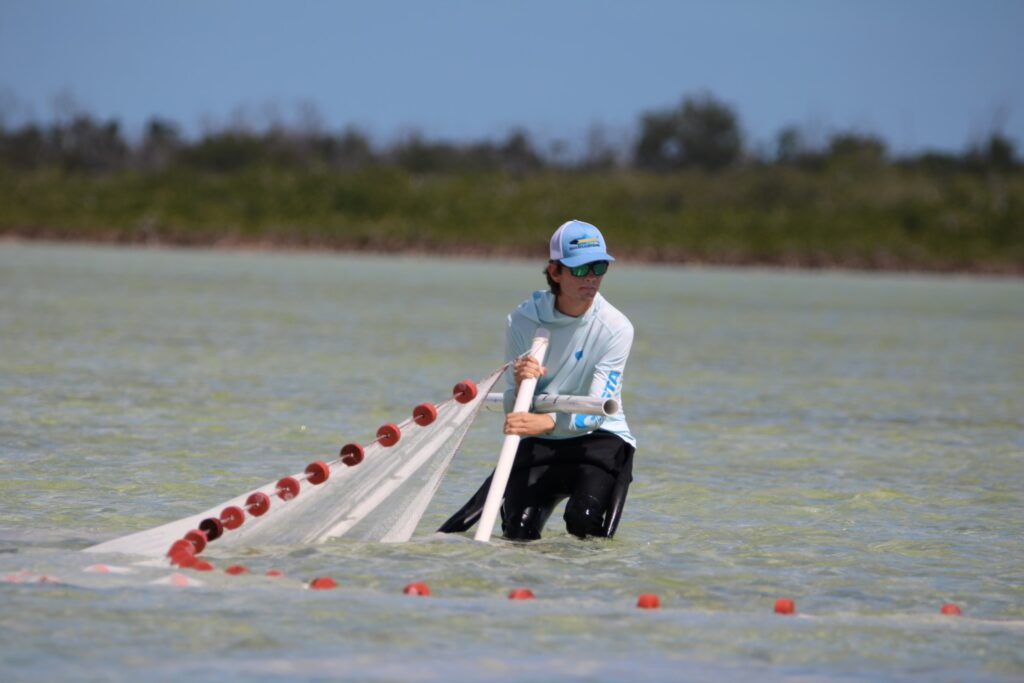By Chris Santella
Photo: Christina Wilson / FWC
When the COVID-19 pandemic swept across college campuses, most students hunkered down to endure months of uninspired online education, augmented with marathon video game/Tik-Tok sessions.
Elijah Dwoskin headed to the Keys. To work for free.
And Dr. Ross Boucek and Bonefish & Tarpon Trust gained a valuable human asset for its bonefish pre-spawning aggregation (PSA) studies.
A native of Atlanta, Dwoskin’s interest in conservation springs from an early passion for fishing. “When I was ten, I had a friend whose dad was great fishermen,” Dwoskin recalled. “He’d take us to North Carolina to fish on the weekends. From that point on, I was camping and fishing every available opportunity. It occurred to me that fishing guides might have the best possible job.”
Dwoskin began doing conservation work in high school, doing a stint with the Youth Conservation Corp in Yellowstone. By college, he was guiding trout anglers in Colorado. “Making an income off something I love to do was an incredible opportunity,” he said. “But I realized that catching 10 or 15 fish a day takes a toll on the resource. The more I interacted with it, the more I realized I should be doing more to protect it.”
After matriculating at University of Georgia, Dwoskin (who’s majoring in Ecology and Environmental Economics and Management) became involved with Trout Unlimited’s Costa 5 Rivers Program, a network of more than 100 TU-affiliated college fishing clubs around the country focused on conservation. The University of Georgia chapter’s main focus was a clean-up of Crayfish Creek, a tributary of the Chattahoochee River. “Crayfish Creek is a major source of silt,” Dwoskin explained. “We did a lot of grass-roots fundraising to conduct stream restoration, working with the National Park Service, Georgia Department of Natural Resources and corporate sponsors. Over $200,000 was raised, and work began in the fall of 2021.”
After almost two semesters of pandemic-driven distance learning, Dwoskin decided it was time for a productive break from school. “I reached out to Dr. Ross Boucek at Bonefish & Tarpon Trust in the fall of 2020 as I knew about the kind of work they were doing, in part from my work with Costa and TU,” Dwoskin said. “Dr. Boucek mentioned the bonefish pre-spawning aggregation [PSA] project, but said that I would not have enough work to justify being down there full-time and unpaid. But there would be some occasional work in the winter of 2021. So I flew down to the Keys for the full moon search every month last spring.”
In 2011, scientists first documented that bonefish migrate offshore to spawn, sometimes as far as 70 miles. At the end of their spawning migration, they first gather in large schools, the pre-spawning aggregations. These PSAs can number 10,000 bonefish; at dusk, the aggregation of fish moves offshore, where they descend hundreds of feet to spawn. After spawning, they return to their home flats. After identifying key PSA sites, BTT works with government agencies to enact regulations to provide protection for these areas during the spawning periods.
“Elijah has been an absolute pleasure to work with,” Dr. Boucek said. “I usually take on one or two interns a year, and press them professionally until they reach their ceiling. You usually find that ceiling pretty quickly. It’s been hard for me to find Elijah’s ceiling, where his abilities stop. Beyond long hours entering data into spreadsheets, he’s doing sophisticated computer coding. Elijah is also very well spoken. I’m happy to put him in front of stakeholders – scientists, well-known guides. No one has any bad things to say about this young man. He gives me hope for future generations.”
Dwoskin proved to be such a talent that Dr. Boucek and BTT brought him back for the winter and spring of 2022. During his second season, Dwoskin also conducted his own “graduate student-style” research, tracking the efficiency and accuracy of BTT’s acoustic receivers.
With the spring season drawing to a close, Dwoskin is heading west to guide trout anglers in Wyoming. He’ll return to UGA next spring to complete his degree. After that, the future’s uncertain. “I want to continue to do meaningful work in the ecosystem conservation realm,” he shared. “I’ll probably apply to graduate school at some point, but I want to have a little more focus.”
If Dwoskin’s work at BTT is any indication of his potential, there will be a long line of research-oriented universities vying to attract his attention.
Chris Santella is the author of 21 books, including the popular “Fifty Places” series from Abrams. He’s a regular contributor to The New York Times, The Washington Post, and Trout.




